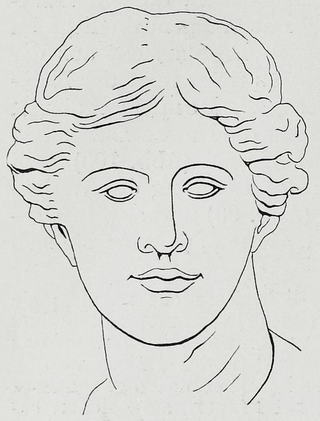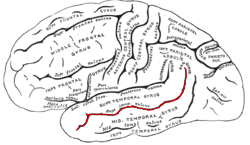Categorization is a type of cognition involving conceptual differentiation between characteristics of conscious experience, such as objects, events, or ideas. It involves the abstraction and differentiation of aspects of experience by sorting and distinguishing between groupings, through classification or typification on the basis of traits, features, similarities or other criteria that are universal to the group. Categorization is considered one of the most fundamental cognitive abilities, and it is studied particularly by psychology and cognitive linguistics.

Facial perception is an individual's understanding and interpretation of the face. Here, perception implies the presence of consciousness and hence excludes automated facial recognition systems. Although facial recognition is found in other species, this article focuses on facial perception in humans.
The physical attractiveness stereotype, commonly known as the "beautiful-is-good" stereotype, is the tendency to assume that physically attractive individuals, coinciding with social beauty standards, also possess other desirable personality traits, such as intelligence, social competence, and morality. The target benefits from what has been coined as “pretty privilege”, namely social, economic, and political advantages or benefits. Physical attractiveness can have a significant effect on how people are judged in terms of employment or social opportunities, friendship, sexual behavior, and marriage.
In cognitive psychology, chunking is a process by which small individual pieces of a set of information are bound together to create a meaningful whole later on in memory. The chunks, by which the information is grouped, are meant to improve short-term retention of the material, thus bypassing the limited capacity of working memory and allowing the working memory to be more efficient. A chunk is a collection of basic units that are strongly associated with one another, and have been grouped together and stored in a person's memory. These chunks can be retrieved easily due to their coherent grouping. It is believed that individuals create higher-order cognitive representations of the items within the chunk. The items are more easily remembered as a group than as the individual items themselves. These chunks can be highly subjective because they rely on an individual's perceptions and past experiences, which are linked to the information set. The size of the chunks generally ranges from two to six items but often differs based on language and culture.

Physical attractiveness is the degree to which a person's physical features are considered aesthetically pleasing or beautiful. The term often implies sexual attractiveness or desirability, but can also be distinct from either. There are many factors which influence one person's attraction to another, with physical aspects being one of them. Physical attraction itself includes universal perceptions common to all human cultures such as facial symmetry, sociocultural dependent attributes, and personal preferences unique to a particular individual.

Facial symmetry is one specific measure of bodily symmetry. Along with traits such as averageness and youthfulness, it influences judgments of aesthetic traits of physical attractiveness and beauty. For instance, in mate selection, people have been shown to have a preference for symmetry.
Lawrence W. Barsalou is an American psychologist and a cognitive scientist, currently working at the University of Glasgow.
The greebles are artificial objects designed to be used as stimuli in psychological studies of object and face recognition. They were named by the American psychologist Robert Abelson. The greebles were created for Isabel Gauthier's dissertation work at Yale, so as to share constraints with faces: they have a small number of parts in a common configuration. Greebles have appeared in psychology textbooks, and in more than 25 scientific articles on perception. They are often used in mental rotation task experiments.
The concept of motor cognition grasps the notion that cognition is embodied in action, and that the motor system participates in what is usually considered as mental processing, including those involved in social interaction. The fundamental unit of the motor cognition paradigm is action, defined as the movements produced to satisfy an intention towards a specific motor goal, or in reaction to a meaningful event in the physical and social environments. Motor cognition takes into account the preparation and production of actions, as well as the processes involved in recognizing, predicting, mimicking, and understanding the behavior of other people. This paradigm has received a great deal of attention and empirical support in recent years from a variety of research domains including embodied cognition, developmental psychology, cognitive neuroscience, and social psychology.
Roberta "Bobby Lou" Klatzky is a Professor of Psychology at Carnegie Mellon University (CMU). She specializes in human perception and cognition, particularly relating to visual and non-visual perception and representation of space and geometric shapes. Klatzky received a B.A. in mathematics from the University of Michigan in 1968 and a Ph.D. in psychology from Stanford University in 1972. She has done extensive research on human haptic and visual object recognition, navigation under visual and nonvisual guidance, and perceptually guided action.

In the human brain, the superior temporal sulcus (STS) is the sulcus separating the superior temporal gyrus from the middle temporal gyrus in the temporal lobe of the brain. A sulcus is a deep groove that curves into the largest part of the brain, the cerebrum, and a gyrus is a ridge that curves outward of the cerebrum.
Dichotic listening is a psychological test commonly used to investigate selective attention and the lateralization of brain function within the auditory system. It is used within the fields of cognitive psychology and neuroscience.

The cheerleader effect, also known as the group attractiveness effect or the friend effect, is a proposed cognitive bias which causes people to perceive individuals as 1.5–2.0% more attractive in a group than when seen alone. The first paper to report this effect was written by Drew Walker and Edward Vul, in 2013.
The face inversion effect is a phenomenon where identifying inverted (upside-down) faces compared to upright faces is much more difficult than doing the same for non-facial objects.
The occipital face area (OFA) is a region of the human cerebral cortex which is specialised for face perception. The OFA is located on the lateral surface of the occipital lobe adjacent to the inferior occipital gyrus. The OFA comprises a network of brain regions including the fusiform face area (FFA) and posterior superior temporal sulcus (STS) which support facial processing.
The eye-contact effect is a psychological phenomenon in human selective attention and cognition. It is the effect that the perception of eye contact with another human face has on certain mechanisms in the brain. This contact has been shown to increase activation in certain areas of what has been termed the ‘social brain’. This social brain network processes social information as the face, theory of mind, empathy, and goal-directedness.
Susan J. Lederman is a Canadian experimental psychologist. She is a professor emerita in the Department of Psychology at Queen's University in Kingston, Ontario, Canada. She is recognized for her contributions to the field of haptics.
Anna M. Borghi is a cognitive psychologist known for her work on embodied cognition and embodied language comprehension. She is Associate Professor of Psychology at the Sapienza University of Rome and an associate researcher at the Institute of Cognitive Sciences and Technology, Italian Research Council. Borghi serves as Specialty Chief Editor of Frontiers in Psychology.
Tania Lombrozo is an American psychologist who is the Arthur W. Marks Professor of Psychology at Princeton University. She oversees the Concepts and Cognition Laboratory, which looks to understand the science that underpins cognition.
Janice Elizabeth Murray is a Canadian–New Zealand academic psychologist, and is professor emerita at the University of Otago. Her research focuses on object and face recognition, and age-related changes in perception.




